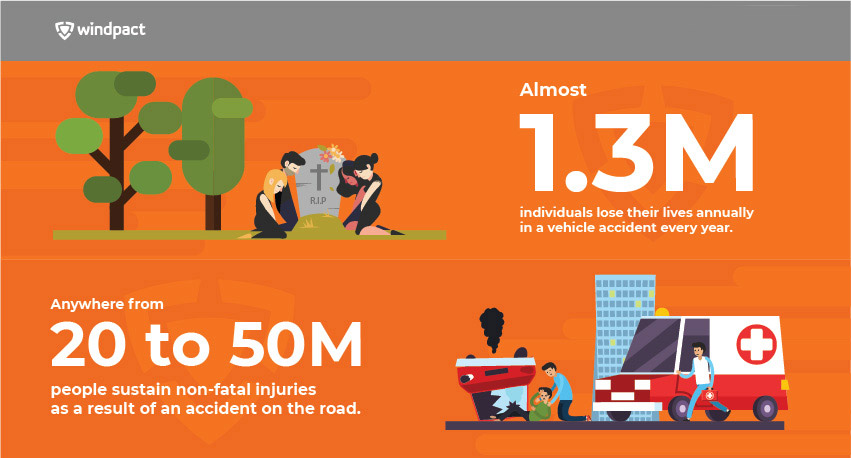How research is helping make car accidents less fatal for children, teenagers, and adults.
Almost 1.3 million individuals lose their lives in a vehicle accident annually. Additionally, anywhere from 20 to 50 million people sustain non-fatal injuries as a result of an accident on the road.
In terms of costs, the National Center for Injury Prevention and Control estimates that injuries related to vehicle accidents cost over $70 billion annually.

How Impact Research Can Help Reduce Fatal Accidents and Injury Costs
One of the main goals of impact research initiatives is to reduce the physical and economic costs associated with motor vehicle accidents.
One of the most exciting developments we’ve seen is led by Dr. Joel Douglas Stitzel, Jr., Ph.D, associate head of the Wake Forest University School of Biomedical Engineering and Sciences.
Dr. Stitzel’s research and findings are helping improve the way impact-resistant materials are designed. Windpact’s comprehensive database of foams and FEA modeling draw upon the same principles of prediction and risk reduction, as Dr. Stitzel does. It is research like this that allows manufacturers and governing bodies to design better safety guidelines and gear in both the sports and automotive industries.
As one of Windpact’s closest collaborators, Dr. Stitzel’s research focus has been pivotal to our team’s mission towards developing reliable impact solutions and risk-reductive gear for all ages.
Specifically, his research has helped us understand the specific injury risks for infants, teenagers, and adults, following a vehicle accident. In short, the risk of injuries is different for infants, teenagers, and adults. The risks must be measured differently. As a result, the way gear is made, and even clinical recommendations in rehabilitation work should adjust accordingly.
In this article we will discuss:
- How youth and pediatric disability risk present differently than adult disability risk.
- How predictive modeling such as those used by the Wake Forest team are critical drivers of recommendations for physicians and engineers.
- How this type of modeling is one of the newest frontiers in applied sciences and engineering solutions.
- Translational research directly leads to safety improvements in many industries.
Windpact’s research interests overlap with this youth disability risk research protocol, and the driving principles underlying predictive modeling and generating solutions will be discussed.
Pediatric disability risk is separate from adult disability risk
Pediatric mortality as a result of severe injuries is typically fairly low, according to the Center for Disease Control’s recent infographic on the Ten Leading Causes of Death by Age Group. While fatalities as a result of motor vehicle accidents are similarly low, the lasting disabilities faced by youth following these accidents can range in severity.

The lack of a reliable metric for quantifying youth disability risk has been a challenge for impact and medical research. Youth disability outcomes are different from adult disability outcomes; children who receive care in a treatment center often have a better prognosis, but identifying which individuals require this immediate triage to a treatment center is difficult.
Why It’s Difficult to Identify Serious Injuries Following a Vehicle Accident
- Pediatric metrics previously were established in accordance with adult disability risk assessments (DRs), which are alleged to contribute to the overarching issue of youth under/over triage to TCs.
- Pediatric patients from motor vehicle accidents are affected differently from adults. Put simply, they are in the age where they’re developing major areas of their bodies, and an accident compromises this development. Adults are already developed.
- The current framework for assessing pediatric disability outcomes involves a multitude of neuropsychological questionnaires such as the Child Health Questionnaire, Glasgow Outcome Scale, the Pediatric Quality of Life Inventory, and Functional Independence Measure (FIM).
Thus, the lack of a comprehensive metric for establishing pediatric disability risk assessment for multiple injuries types needed to be addressed, and Dr. Stitzel’s team set about designing this tool as a focus of the current study.
A Better Method for Identifying Injuries
The method involved determining the most common (95%) types of injuries resulting from motor vehicle accidents as scored by the Abbreviated Injury Scale (AIS), a code indexed system that classifies injury severity requiring treatment.
The data set of interest was sampled from a comprehensive national database of pediatric patients who had sustained an injury in an automobile accident as measured by the AIS.
Then, they assessed body motor functions following the injury, and the values were processed to produce a continuous disability risk metric that classified types of injuries and their predicted disability risk.
Establishing a Consistent Metric to Measure Disability Risk in Young People
By using a continuous disability risk as a metric for establishing youth risk in the long term, the predictive power of the model determines which types of injuries can produce the most significant disability. These have ramifications for determining treatment, triage, and rehabilitation for youth during these critical years.
Through this work, governing bodies that direct clinical care and automotive safety requirements are better appraised of the nature of injury and rehabilitation. The process of designing the hardware that fulfills these requirements is expedited by Windpact’s database of safety material and virtual modeling capabilities, which are to be explored in the following section.
Predictive Modeling as a Tool for Finding Solutions
Working directly with Dr. Stitzel, Windpact understands the role that predictive modeling and data-driven research plays in solving the problems of safety and utility. Therefore, in designing products such as the Crash Cloud, the type of informative research that Dr. Stitzel and colleagues engage in are the keynote principles behind our product testing and design.
Metric design and prediction have a certain commonality that we are interested in as an applied engineering firm. We can draw conclusions about risk, safety, and recommendations before creating physical models.
While the work conducted by the team at Wake Forest informs physicians and treatment care facilities, Windpact’s proprietary database of foams and FEA modeling capabilities inform designers about performance specs before hard model production.
We have developed impact and design quality standards in our process as a result of working closely with experts in predictive metrics. The goal is to translate the findings of the extensive impact research we perform, into applicable measures. This is how Windpact remains at the forefront of impact engineering solutions.
Applying research into action
How translational impact research paves the way for cutting-edge technological advances
Translational science is any basic research that “translates” into novel therapies, interventions, or guidelines that improve health or technology.
Translational research discoveries that drive innovation are the foundation of Windpact’s technology, and we’re not alone. Research initiatives that inform policy, treatment, and design are how lasting impacts are made. Bench science paves the way for smarter solutions and has done so since the inception of translational science as a field of study.
On the same token, consider how a project demands not only ingenuity and a knack for aesthetics but also an ability to synthesize the current state of research. This has ramifications for all areas of industry, including medicine, civil planning, engineering, and legislation; furthermore, projects grounded in and informed by translational research can only benefit the consumer.
Clinical studies such as those conducted by Dr. Stitzel have driven and shaped Windpact’s mission, resulting in major advances in the technologies we are proud of.
How Windpact’s Research Efforts Help Breakthrough Safety Technology
Youth disability risk requires a multifaceted analysis approach in order to best direct rehabilitation and treatment center triage.
In the same lane, solving the problem of impact injury and answering safety guidelines requires a similar framework that includes predictive modeling, comprehensive data points, and guidance from industry experts on the best design approaches.
In creating these models, Windpact draws upon reliable and unprecedented simulation data to produce recommendations that save clients time, money, and energy. These result in faster speed to market, and an assurance that your model adheres to the current guidelines while surpassing the impact results of the competition.
As a Platform as a Service (PaaS), Windpact provides the tools and software needed to create design solutions, the same kind of solutions that mitigate injury risk and maintain material integrity.
This industry relies on research and technology that allows us to predict what may happen in the real world. In this way, we can establish reliable metrics that the NFL, DoD (i.e., U.S. Army) and NOCSAE use for championing safety science initiatives that save lives and maintain the quality of life for players and soldiers both in and out of the professional realm. Our superior modeling capabilities coupled with our proprietary materials database enables Windpact to down select the material compositions using data as our guide, create and test targeted prototypes, and ultimately manufacture the final optimized impact solution for our co-branded partners.
